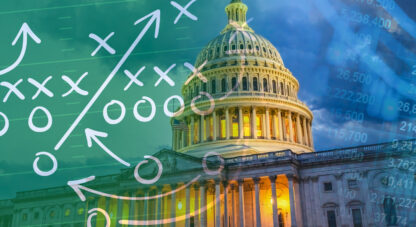Is Our Currency System Facing a “Total Catastrophe”?
This week, HAI is being composed on the shores of the Mississippi in the great city of New Orleans, Louisiana. This author is attending the famed New Orleans Investment Conference, and so far the event has been spectacular. Market action over the week, however, I would describe as considerably less than spectacular. Another week of hot inflation surprises continues to escort the Fed, markets, and the economy toward a reckoning.
The following axiom chronicled by the great Austrian economist Ludwig Von Mises isn’t cheery, and you’ve seen it in HAI before, but it’s especially accurate and is particularly germane to our modern macro moment.
There is no means of avoiding the final collapse of a boom brought about by credit expansion. The alternative is only whether the crisis should come sooner as the result of voluntary abandonment of further credit expansion, or later as a final and total catastrophe of the currency system involved.
The Fed and markets are stuck in a lobster trap somewhere between a rock and a hard place. The Fed has been pursuing credit expansion as policy for decades. With such a policy, according to the Austrian school of thought, first you get monetary inflation, then comes asset price inflation, and eventually, in the last stage, consumer price inflation emerges. Clearly, headlines have caught up with theory, and they are in virtual lockstep.
Monetary authorities can no longer pursue the same credit expansion policies that have defined modern monetary practice without stoking the inflation problem. And make no mistake, the situation is unsustainable. Real (inflation adjusted) wage “growth” is running at negative 3.9%, savings rates have plunged below pre-Covid levels, and credit card debt is surging to cover the cost of living. It’s a problem made increasingly more severe the longer the conditions persist.
We have a severe bind for policymakers. They can attack inflation, but the policies necessary to do so put the pin to the credit bubble and threaten immediate crisis, one that in our case would likely be nothing short of devastating. The other option? They can aim to keep the credit bubble inflated a while longer with more easy monetary policy, credit expansion, and devastating inflation. The latter option comes at the cost of an even bigger crisis at a later date, one ultimately involving a “total catastrophe of the currency system involved.”
Policymakers find themselves at this critical juncture as we speak. It’s a pivotal moment, decades in the making.
So now, with the inflation genie out of the bottle, we’re seeing the central bank policy response. For the moment, it’s a “voluntary abandonment of further credit expansion.” The Fed has unleashed higher interest rates and quantitative tightening, both of which have contributed to a surging dollar. The combination of higher interest rates, quantitative tightening, and the surging dollar are resulting in substantially tighter financial conditions. Tighter financial conditions act as a break on the economy, and that break is the tip of the Fed’s spear in the war on inflation. The Federal Reserve assures us, with promises made in the name of Paul Volker, that they will continue to use that monetary policy break until they bring inflation down to their 2% target, “unconditionally.”
In spite of such efforts, this was not a good week on the inflation front. The latest CPI inflation report is further confirmation that the data will not easily let the central bank off the hook. As long as the Fed has any intention of maintaining a shred of credibility, it has no choice but to continue to slam on the economic brakes and administer policy poison to an economy structurally unable to handle it. This week, headline CPI came in at 8.2% vs. expectations of an 8.1% reading. But the real story was core CPI (ex food and energy), where the reading was much hotter than anticipated. At 6.6%, core CPI outpaced last month’s 6.3% and notched a brand new 40-year high. An unwelcome milestone to be sure.
In addition, the University of Michigan Surveys of Consumers showed year-ahead inflation expectations rose in early October, and the long-term outlook also crept higher. The uptick is a reversal to the recent downtrend, and is worrisome to a Federal Reserve that knows it absolutely must keep inflation expectations anchored. So for the Fed and its unconditional inflation fight, it’s back to work. The implication is, unequivocally, higher rates for longer. For markets, that effectively translates to higher levels of heat exposure for longer, and that’s not a pretty picture.
Still, the impact of policy implementation is not always immediate. The full impact of higher rates on the economy works on a lag. The minimum estimate of that lag is six months. That means we are just starting to feel the full impacts of the initial modest hikes. The majority of impacts resulting from the subsequent string of jumbo rate hikes is still ahead of us.
To underscore the extent of the problem, or the scope of dry kindling for the likely imminent fire, consider the following: Estimates suggest that roughly 20% of companies today qualify as “zombie corporations.” That’s defined as EBITDA (Earnings Before Interest Taxes, Depreciation, and Amortization) profit that is less than what the company is paying on interest expense for their debt (debt servicing costs).
That’s shocking! Some estimates are of an even higher percentage of companies. In other words, these companies are alive only because they borrow nearly free money to pay expenses, and then borrow even more nearly free money to pay the nearly non-existent interest on that debt. At higher interest rates for a longer time, all of these companies are smoking charcoal toast. The current number of zombies is three times higher than during the 2008 great financial crisis. Prior to the 2000 dot-com era, when interest rates maintained higher levels, we never had more than 2% of companies meeting the zombie criteria. The rates rampage is likely to bring a blowtorch to this economy.
Structurally fragile markets, however, are already starting to smoke and in some cases ignite. As crisis dynamics deepen and spread, the pressure builds on the Fed to ease policy. That said, a premature policy pivot, with inflation still elevated, is an extremely problematic option. Such a pivot would almost certainly confirm the secular inflation thesis and ignite a definitive crisis of confidence in modern monetary policy and policymakers.
So the Fed is at a crucial crossroads. The implications of the Fed’s policy trajectory are serious, and carry over directly into financial markets. Waver on the inflation fight, and this could be a major turning point for gold and other select hard assets. Stay hawkish for longer than expected, and all assets may face varying degrees of significant further pressure. For now, investors should stay defensive and expect more hawkishness for longer from the Fed. While cases of markets breaking (such as UK guilts) have started to erupt around the world, at this point, they are not likely top of mind for America’s central bankers. Those rest-of-world problems may have to manifest domestically before the Fed is ready to start “thinking about thinking about” some sort of policy pivot. Until that pivot point, the risk to asset prices remains substantial.
Weekly performance: The S&P 500 was down 1.55%. Gold was lower by 3.53%; silver was crushed on the week, down 10.77%; platinum was off by 2.51%; and palladium suffered big losses, down 8.85%. The HUI gold miners index was slashed by 7.19%. The IFRA iShares US Infrastructure ETF lost a modest 0.92%. Energy commodities were lower on the week. WTI crude oil lost 7.59%, while natural gas was down 4.37%. The CRB Commodity Index was off by 3.13%, while copper managed a rare gain, up 0.88%. The Dow Jones US Specialty Real Estate Investment Trust Index was lower by 3.11% on the week, while the Vanguard Utilities ETF (VPU) was down 2.16%. The dollar added 0.46% to close the week at 113.20. The yield on the 10-yr Treasury was higher by 11 bps to end the week at 4.00%
Have a wonderful weekend!
Best Regards,
Morgan Lewis
Equity Analyst & Investment Strategist
MWM LLC















